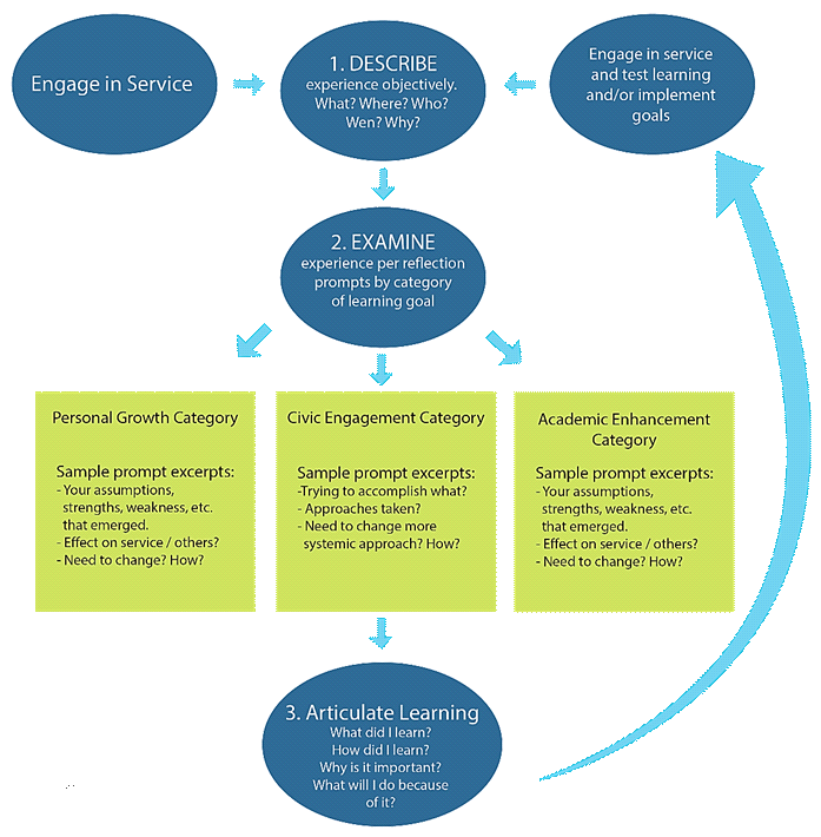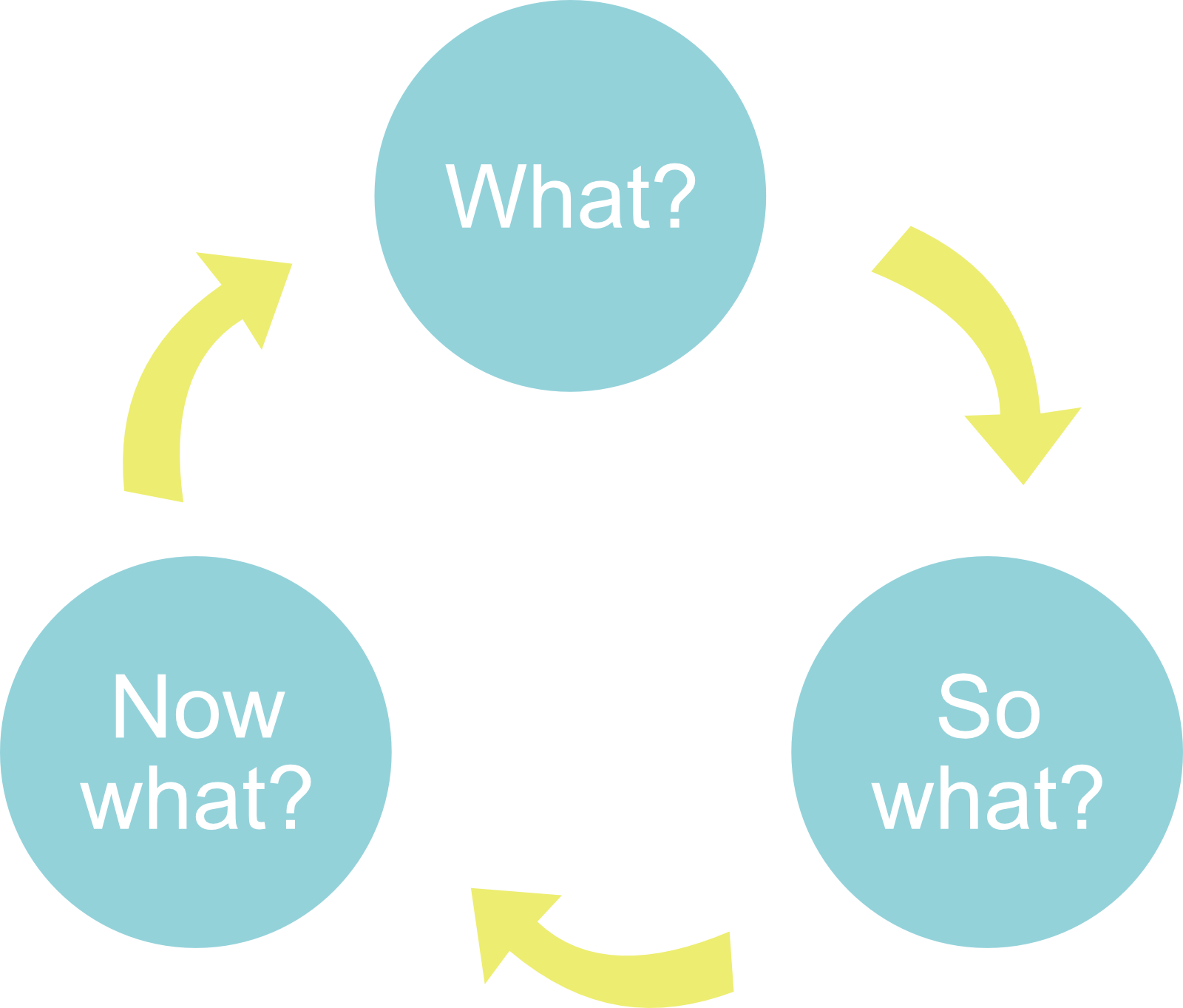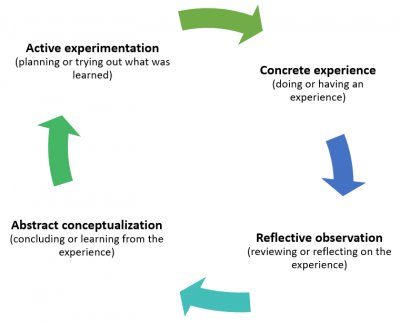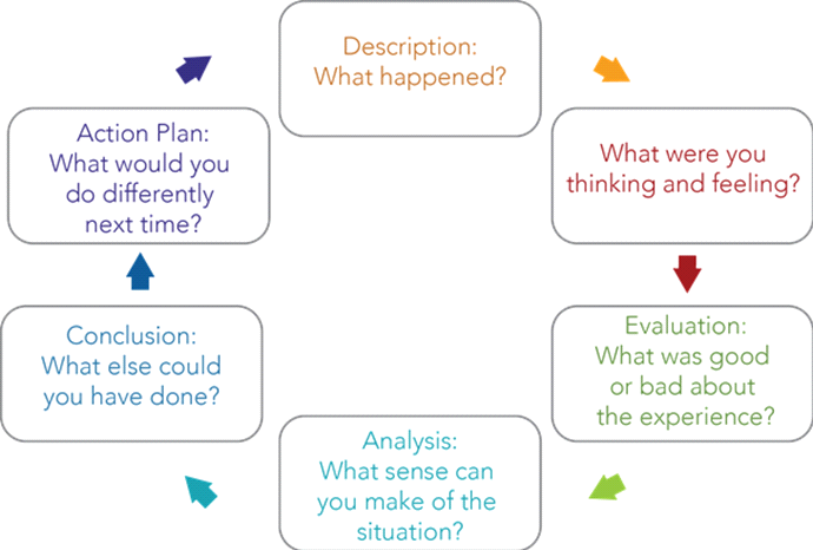Reflection Models
DEAL: Describe, Examine, and Articulate Learning
Ash & Clayton (2009) define critical reflection as “evidence based examination of the sources of and gaps in knowledge and practice with the intent to improve on both (p. 28).” The three steps of the DEAL model are Describe, Examine, and Articulate Learning. The DEAL model works well for experiential, civic, or service learning related activities.

Step 1: Describe
Task: Objectively describe an experience
Potential prompts:
What did you do?
Why did you do it?
When did this experience take place?
Where did it take place?
Who else was there?
Who wasn’t there?
What was communicated by you or others?
What else happened that might be important?
Step 2: Examine
Task: Examine the experience by category of learning goal, such as personal growth, academic enhancement, or civic engagement
Potential prompts: Personal growth: What assumptions did you make? What personal strengths emerged as you participated? What personal weaknesses emerged as you participated? What effect did you, including your strengths and weaknesses, have on the service provided? What effect did you, including your strengths and weaknesses, have on others? What do you need to change and how will you do that?
Academic enhancement: What academic (disciplinary, intellectual, professional) skills and knowledge did you use or should you have used? In what ways were your understanding of the material, skills, or experience the same or different than those of others? What are the possible reasons for the differences or similarities? Did you approach the experience from a specific discipline perspective and if so how and how did it impact the experience? What knowledge assumptions did you make? What knowledge or skill strengths emerged as you participated? What knowledge or skill weaknesses emerged/developed as you participated? What impact did your knowledge and skills, including strengths and weaknesses, have on the service provided? What effect did your knowledge and skills, including strengths and weaknesses, have on others? What differences between your textbook and your community experience were noted?
Civic engagement: How can you or others in the community use what you learned about the course material and are there any challenges associated with doing so? How did this experience differ from your initial expectations? What was the civic goal you were trying to accomplish and did you achieve your goal? How did your skills contribute to the diversity of the people with whom you worked and how did you harness those differences for maximal effectiveness? Did your assumptions about members of the community make your experience more or less successful when accomplishing your objectives? How did your personal values regarding civic engagement play a role in helping you to accomplish your goal? How did this experience increase your sense of responsibility for acting on behalf of others? How did this experience inspire you to continue a commitment to serving others? What steps have you taken or do you plan to take to implement this plan of continued commitment?
Step 3: Articulate learning
Task: Using responses in steps 1 and 2, verbalize what learning has occurred, linking it back to the original learning objective
Potential prompts: What did you learn? (“I learned that…”) Why does it matter? (“This learning matters because…”) What should be done in light of it? (“In light of this learning…”)
- Express an important learning, not just a statement of fact
- Provide a clear and correct explanation of the concept(s) in question so that someone not in the experience could understand it.
- Explain your enhanced understanding of the concept(s), as a result of reflection on the experience
- Be expressed in general terms, not just in the context of the experience (so that the learning can be applied more broadly to other experiences)
- Connect the learning to specific activities that gave rise to it, making clear what happened in the context of that experience so that someone who wasn’t there could understand it.
- Consider how the learning has value, both in terms of this situation and in broader terms, such as other organizations, communities, activities, issues, professional goals, courses, etc.
- Set specific and assessable goals; consider the benefits and challenges involved in fulfilling them
- Tie back clearly to the original learning statement.
Ash, S. L., & Clayton, P. H. (2009). Generating, deepening, and documenting learning: The power of critical reflection for applied learning. Journal of Applied Learning in Higher Education, 1(1), 25-48. Ash, S.L. & Clayton, P.H. (2004). The Articulated Learning: An Approach to Guided Reflection and Assessment. Innovative Higher Education, 29(2). pp. 137-154. Ash, S.L., Clayton, P.H., & Atkinson, M. (2005). Integrating Reflection and Assessment to Capture and improve Student Learning. Michigan Journal for Community Service-Learning, ll(2). pp. 49-59. Ash, S.L., Clayton, & Moses. (2009). Learning through Critical Reflection: A Tutorial for Service-Learning Students. Raleigh, NC. Clayton, P.H. & Ash, S.L. (2004). Shifts in perspective: Capitalizing on the counter-normative nature of service- learning. Michigan Journal of Community Service-Learning, 1 l(1). pp. 59-70. Clayton, P.H. & Ash, S.L. (2005). Reflection as a key component in faculty development. On the Horizon, 13(3). Clayton, P.H., Ash, S.L., Bullard, L.G., Bullock, B.P., Day, M.G., Moore, A.C., O'Steen, W.L., Stallings, S.P., & Usry, R.H. (2005). Adapting a core service-learning model for wide-ranging implementation: An institutional case study. Creative College Teaching. Vol2, Spring. pp. 10-26.
What? So what? Now what? Model
A well-known reflection model developed by Rolfe et al (2001) is based upon three simple questions: What? So what? Now what?

Step 1: What?
Task: Describe in detail the experience
Potential prompts:
What happened?
What did you observe?
What was your role?
What issue is being addressed or population is being served?
What were your initial expectations?
What was good/bad about the experience?
What did you learn from the experience?
What part of your experience was most challenging?
What part did you find surprising?
What did you already know about the topic you explored at the site/event/project?
Who did you work with?
Step 2: So What?
Task: Describe why this experience was significant
Potential prompts:
What critical questions does this information cause you to ask?
What about the event stuck out to you/made an impact on you?
What emotions does it evoke? How does it make you feel?
What broader issues arise from the situation at hand?
What conclusions can you draw from the experience?
What did you learn about others and yourself?
How were you different when you finished this experience?
How were you different/similar to other people involved?
How did being different help/hinder?
What values, opinions, decisions have been made or changed through this experience?
What new skill did you learn?
How did this experience clarify, expand, or create an interest?
What about this experience surprised you?
What impacts the way you view the situation/experience?
What did you learn about the project/topic/people/community?
What are some of the pressing needs/issues related to this project/topic/people/community?
How does this project address those needs?
How did the experience relate to your coursework?
How has your understanding of the project/topic/people/community changed as a result of your participation in this project?
Step 3: Now What?
Task: Describe next steps
Potential prompts:
How will you apply what you learned from your experience?
What would you like to learn more about, related to this project or issue?
What follow-up is needed to address any challenges or difficulties?
What information can you share with your peers or the community?
If you could do the project again, what would you do differently?
Have your career options been expanded by your service experience?
How can you continue your involvement with this group or social issue?
How will your efforts on this project contribute to social change?
How will your efforts on this project contribute to your career?
How can society better address the problem from the project?
Where do you go from here? What is the next step in the process?
Rolfe, G., Freshwater, D., Jasper, M. (2001) Critical reflection in nursing and the helping professions: a user’s guide. Basingstoke: Palgrave Macmillan.
Kolb's Theory
Kolb's theory works on two levels. First, it works on a four-stage cycle of learning. Second, it works to address four separate learning styles. This combination creates a focus on the student’s internal cognitive processes because he believes that learning involves the acquisition of abstract concepts applied flexibly in a variety of situations. Kolb’s theory addresses 4 learning styles:
| Diverging | Emphasizes the innovative and imaginative approach to doing things. Views concrete situations from many perspectives and adapts by observation rather than by action. Interested in people and tends to be feeling-oriented. Likes such activities as cooperative groups and brainstorming. |
| Assimilating | Pulls a number of different observations and thoughts into an integrated whole. Likes to reason inductively and create models and theories. Likes to design projects and experiments. |
| Converging | Emphasizes the practical application of ideas and solving problems. Likes decision-making, problem-solving, and the practical application of ideas. Prefers technical problems over interpersonal issues. |
| Accommodating | Uses trial and error rather than thought and reflection. Good at adapting to changing circumstances; solves problems in an intuitive, trial-and-error manner, such as discovery learning. Also tends to be at ease with people. |
According to Kolb, effective learning occurs when a person undergoes a concrete experience followed by observation of and reflection on that experience which leads to the formation of abstract concepts (analysis) and generalizations (conclusions) which are then utilized to test future hypotheses, resulting in new experiences. Because this can be simplified to (1) experience, (2) reflect, (3) reframe, and (4) reform, it leads to a model similar to “What? So what? What now?” therefore similar prompts can be utilized for this model.

Kolb, David A. Experiential Learning: Experience as the Source of Learning and Development. Prentice-Hall, Inc., Englewood Cliffs, N.J. 1984
Kolb, D. A. (2014). Experiential learning: Experience as the source of learning and development. FT press.
Gibbs’ Model of Reflection
The Gibbs’ (1988) reflection model can is particularly useful for helping students learn from situations that they experience regularly, particularly those that do not go as anticipated. Although this model can be easy for beginners because it has six steps to work through, it has been criticized for a lack of critical thinking and analysis or an attempt for the student to view the experience from different perspectives.

Step 1: Description: what happened?
Potential prompts: What, where and when did this happen? What did you do? In what order did things occur? What were you responsible for? What was the result?
Step 2: Feelings: what were you thinking?
Potential prompts: What was your initial reaction, and what does this tell you? Did your feelings change? What were you thinking? What did you feel during / after the situation? What do you think about it now? What do you think other people feel about the situation now?
Step 3: Evaluation: What was good or bad about the experience?
Potential prompts: What went well? What were the challenges? Who/what was unhelpful? Why? What did you and others do to contribute to the situation (positively or negatively)? What needs improvement?
Step 4: Analysis: what sense can you make of the situation?
Potential prompts: What similarities or differences are there between this experience and other experiences? What choices did you make and what effect did they have? What did you do well? What did others do well? What went wrong or did not turn out how it should have done? In what way did you or others contribute to this?
Step 5: Conclusion: what else could you have done?
Potential prompts: What factors that affected the outcome? What might have been some alternative actions or approaches? What might you have done differently? Could negative events be avoided? Could positive events be made more effective?
Step 6: Action plan: what will you do next time?
Potential prompts:
- If a similar situation/experience arose again, what would you do?
- What will you do if you encounter this kind of situation again?
- What will you do in the future to increase the likelihood of similar positive outcomes and minimize the likelihood of similar negative outcomes?
- What do you need to learn?
Gibbs, G. (1988) Learning by doing: A guide to teaching and learning methods. Oxford Further Education Unit, Oxford.
The 5R framework The 5R framework was developed by Bain et al and allows for critical reflection on an experiencing by focusing on the five core stages to make sense of a learning experience. The 5 stages are:
- Reporting of the context of the experience
- Responding to the experience (observations, feelings, thoughts, etc.)
- Relating the experience to knowledge and skills you already have
- Reasoning about the significant factors/theory to explain the experience
- Reconstructing your practice by planning future actions for a similar experience
Sometimes ‘reporting’ and ‘responding’ are presented as one interlinked level. A number of helpful questions as well as key components are outlined below for each of the stages. You don’t have to answer all of them, but they can guide you to what sort of things make sense to include in that stage. You might have others questions that work better for you.
Step 1: Reporting
Task: Providing description of the key elements of the experience/problem
Potential prompts: What happened? What are the key aspects of the experience/situation? Who was involved? What did you do?
Step 2: Responding
Task: Provide your personal response to the situation/experience
Potential prompts: How did what happened make you feel? What did you think? What made you think/feel this way?
Step 3: Relating
Task: Provide your understanding of the situation/experience as it relates to your own knowledge, skills, attitudes, and previous experiences
Potential prompts: What skills/knowledge do you bring to this experience? Have you experienced similar situations/experiences before? How was it the same or different?
Step 4: Reasoning
Task: Explore and explain significant factors within the situation/experience and how they are important to understanding what happened
Potential prompts:
What is the most important aspect of this situation/experience?
Why?
How do different perspectives affect the way you understand the situation?
How would someone who is knowledgeable and experienced with this type of situation/experience respond to it?
Are there theories that can assist in making sense of the situation/experience?
Step 5: Reconstructing
Task: Reframe or reconstruct future experiences/situations by drawing deeper understanding and summary of the learning that occurred
Potential prompts:
What would you do differently in the future if faced with a similar situation/experience?
Are there other options for facing this situation/experience in the future?
Are these ideas supported by theory/fact? What would happen if…?
What changes can be made to benefit others?
Bain, J.D., Ballantyne, R., Mills, C. & Lester, N.C. (2002). Reflecting on practice: Student teachers' perspectives, Post Pressed: Flaxton, Qld
The online jsBeautifier is a free online program that is worth bookmarking.